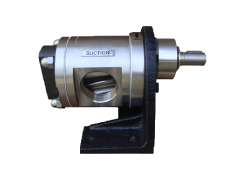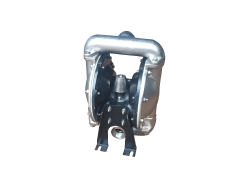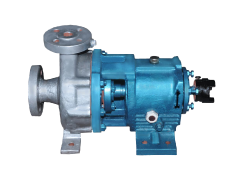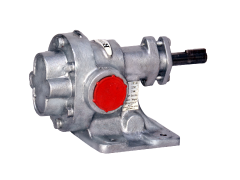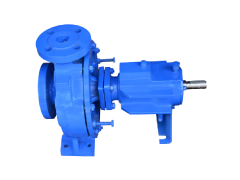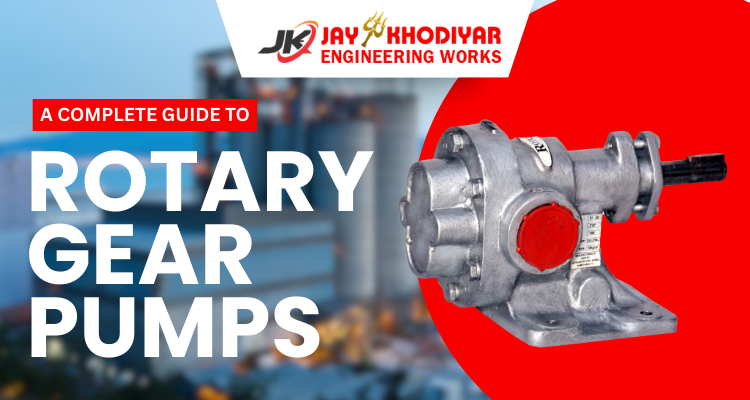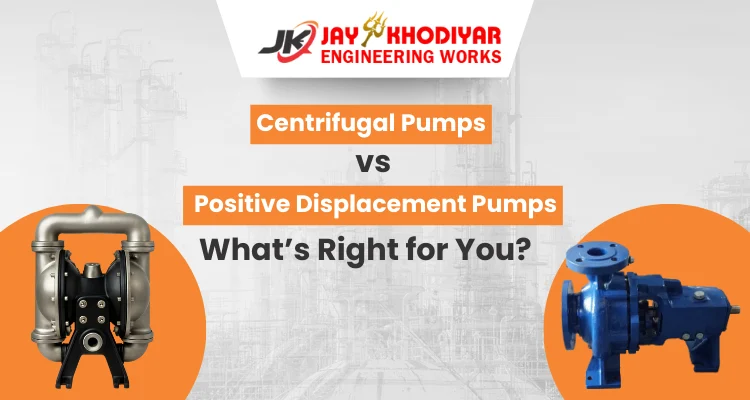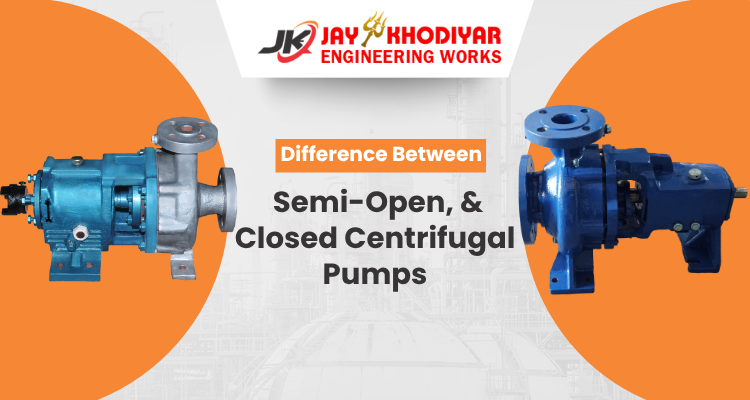
Centrifugal vs Positive Displacement Pumps: What’s Right for You?
August 18, 2025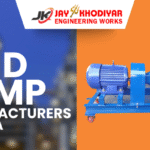
Top Mud Pump Manufacturers in India
October 1, 2025Rotary gear pumps are the workhorses of industrial fluid handling, delivering consistent performance for viscous liquids where centrifugal pumps fail. These positive displacement pumps handle everything from thin oils to thick resins with volumetric efficiencies exceeding 90%.
Whether you're managing chemical processing operations, pharmaceutical manufacturing, or food production, understanding rotary gear pumps can significantly impact your system's efficiency and reliability.
What Are Rotary Gear Pumps and Why Do They Matter?
Rotary gear pumps are positive displacement pumps that use two intermeshing gears to move fluids through a system. Unlike centrifugal pumps that rely on velocity, these industrial gear pumps trap fluid between gear teeth and the casing, forcing it from inlet to outlet.
The magic happens through precise engineering: as gears rotate, they create sealed cavities that carry exact volumes of fluid with each revolution. This means consistent flow rates regardless of pressure variations – a critical advantage in industrial applications.
Benefits of Rotary Gear Pumps:
- Wide viscosity range: Handle fluids from 1 cP to over 1,000,000 cP
- High pressure capability: Operating pressures up to 3,000 psi
- Exceptional accuracy: Flow accuracy within 1% of rated capacity
- Consistent performance: Reliable operation across varying conditions
How Do Rotary Gear Pumps Work?
The operating principle is elegantly simple yet highly effective. Two gears – a driving gear connected to a motor and a driven gear – mesh together inside a tight-fitting casing.
Step-by-Step Operation Process:
1. Gear Rotation: When the driving gear rotates, it turns the driven gear in the opposite direction
2. Suction Creation: This creates a suction effect at the inlet, drawing fluid into the spaces between gear teeth and the pump casing
3. Fluid Transport: As gears continue rotating, trapped fluid moves along the casing walls toward the discharge port
4. Backflow Prevention: The intermeshing gear teeth prevent backflow, ensuring positive fluid displacement with each revolution
Advantages of This Mechanism:
- Self-priming capability: Works effectively when suction lift is required
- Consistent flow: Maintains steady flow regardless of discharge pressure variations
- High efficiency: Excellent performance with viscous fluids where other pumps struggle
Ready to optimize your fluid handling?
What Are the Main Types of Rotary Gear Pumps?
1. External Gear Pumps
External gear pumps feature two identical gears that rotate against each other outside their centers. These are the most common type, ideal for lubrication systems and high-pressure applications up to 3,000 psi.
Construction Features:
- Precision-machined gears with tight tolerances
- Typical clearance: 0.002-0.005 inches
- Maximized efficiency while handling moderate viscosities effectively
Best Applications:
- Hydraulic systems
- Fuel transfer operations
- General industrial applications requiring reliability and high pressure capability
2. Internal Gear Pumps
Internal gear pumps use a rotor (driving gear) inside a larger idler gear, creating a more compact design. The rotor has fewer teeth than the idler, allowing one to rotate inside the other.
Key Advantages:
- Particularly suitable for high-viscosity fluids like resins, adhesives, and thick polymers
- Larger cavities between teeth accommodate viscous materials better than external designs
- Produce smoother flow with less pulsation
- Preferred for applications requiring steady, continuous flow
Features and Applications of Rotary Gear Pumps
Essential Features That Make Rotary Gear Pumps Superior
- Compact and Efficient Design: Space-saving configuration ideal for installations with limited footprint requirements
- Smooth and Noise-Free Operation: Precision-engineered gears minimize vibration and operational noise levels
- High Suction Capability: Excellent performance even with challenging suction conditions and varying inlet pressures
- Low Maintenance: Simple construction with fewer moving parts reduces service requirements and downtime
- Self-Priming: Eliminates the need for external priming systems, ensuring reliable startup every time
- Bi-Directional Flow: Capable of pumping in both forward and reverse directions by changing rotation direction
- Available in Various M.O.C.:Multiple material options including stainless steel, cast iron, and specialized alloys for different applications
Primary Applications Across Industries
- Fuel & Oil Transfer: Reliable handling of petroleum products, diesel, and various fuel grades with consistent flow rates
- Bitumen & Tar Handling: Efficient transfer of high-temperature, viscous materials in road construction and roofing applications
- Paints, Varnish, and Ink Transfer: Precise metering and contamination-free handling of coating materials and printing inks
- Food Grade Liquids (Like Ghee, Chocolate, Syrup): Hygienic processing of edible liquids with FDA-compliant materials and sanitary design
- Soap, Shampoo, and Detergents: Gentle handling of personal care products without affecting texture or quality
- Pharmaceutical & Chemical Industry: Accurate dosing and sterile transfer of high-value medications and specialty chemicals
- Adhesives and Resins: Effective handling of high-viscosity bonding materials and industrial compounds
What Industries Rely on Rotary Gear Pumps?
1. Chemical Processing Applications
Chemical processing demands reliable viscous fluid handling for solvents, acids, and specialty chemicals. Rotary gear pumps handle corrosive materials when constructed with appropriate materials like stainless steel or PTFE-lined housings.
Critical applications include polymer processing, resin transfer, and catalyst circulation where precise metering and contamination-free operation are essential.
2. Oil and Gas Operations
The petroleum industry relies heavily on high viscosity pumps for crude oil transfer, fuel handling, and lubrication systems. Rotary gear pumps maintain consistent flow rates despite varying fluid properties and temperature changes.
Upstream applications include drilling mud circulation, while downstream operations use them for fuel transfer and additive injection systems.
3. Food and Beverage Manufacturing
Food processing requires hygienic design and FDA-compliant materials for handling syrups, chocolate, dairy products, and viscous ingredients. Rotary gear pumps provide contamination-free transfer with easy cleaning capabilities.
Sanitary designs feature smooth surfaces, CIP (Clean-in-Place) compatibility, and food-grade materials that meet strict regulatory requirements.
4. Pharmaceutical and Cosmetics
Pharmaceutical manufacturing demands precise dosing and sterile fluid handling for high-value products. Rotary gear pumps provide accurate metering for ointments, creams, and liquid medications.
The cosmetics industry uses these pumps for lotions, shampoos, and gels where product integrity and consistent texture are critical.
How Do You Choose the Right Rotary Gear Pump?
1. Fluid Properties Assessment
Start by analyzing your fluid's viscosity, temperature range, and chemical compatibility. Viscosity affects pump sizing and material selection, while temperature influences seal materials and clearances.
Key Considerations:
- Viscosity range: Determines pump size and gear design
- Temperature variations: Affects material expansion and seal selection
- Chemical compatibility: Dictates housing materials and coatings
- Abrasive content: Influences gear hardness and wear resistance
Chemical compatibility determines housing materials – stainless steel for most applications, exotic alloys for aggressive chemicals, or lined housings for ultimate corrosion resistance.
2. Flow Rate and Pressure Requirements
Calculate required flow rate in gallons per minute (GPM) and maximum system pressure. Rotary gear pumps are sized based on displacement per revolution, which determines flow rate at given RPM.
Critical Calculations:
- Required flow rate (GPM)
- Maximum system pressure
- Pressure drop through system components
- Motor sizing requirements
Consider pressure drop through your system, including piping, filters, and heat exchangers. This affects pump selection and motor sizing requirements.
3. Material Selection Considerations
Material compatibility extends pump life and prevents contamination. Standard materials include cast iron, stainless steel, and bronze for most applications.
Material Options:
- Standard Applications: Cast iron, stainless steel, bronze
- Corrosive Environments: Exotic alloys, ceramic coatings
- Extreme Chemical Resistance: Lined housings, specialized seal materials
- High-Temperature Applications: Heat-resistant alloys and seals
Specialized applications may require exotic alloys, ceramic coatings, or specialized seal materials like perfluoro elastomers (FFKM) for extreme chemical resistance.
Questions about pump performance and maintenance?
What Makes Rotary Gear Pumps More Efficient Than Alternatives?
1. Performance Comparison with Centrifugal Pumps
While centrifugal pumps excel with low-viscosity, high-flow applications, rotary gear pumps dominate high-viscosity scenarios. Centrifugal pump efficiency drops dramatically as viscosity increases, while gear pumps maintain consistent performance.
Key Performance Differences:
| Factor | Rotary Gear Pumps | Centrifugal Pumps |
|---|---|---|
| Viscosity Performance | Maintains efficiency >90% up to 1,000,000 cP | Efficiency drops significantly above 100 cP |
| Flow Characteristics | Constant flow regardless of pressure | Variable flow based on system pressure |
| Self-Priming | Excellent self-priming capability | Requires priming in most applications |
| Pressure Capability | Up to 3,000+ psi | Typically limited to <500 psi |
2. Energy Efficiency Advantages
Modern rotary pump systems achieve 85-95% overall efficiency through precision manufacturing and advanced materials. Variable frequency drives (VFDs) optimize energy consumption by matching pump speed to demand.
Efficiency Features:
- Reduced slip: Minimized internal losses compared to other positive displacement designs
- Optimized gear profiles: Reduced friction and power requirements
- VFD integration: Match pump speed to actual demand
- Precision manufacturing: Tight tolerances maximize volumetric efficiency
How Do You Maintain Rotary Gear Pumps for Maximum Life?
1. Essential Maintenance Practices
Regular lubrication prevents gear wear and maintains efficiency. Use manufacturer-recommended lubricants and follow scheduled intervals based on operating conditions.
Monitor bearing temperatures and vibration levels to detect potential problems early. Excessive heat or unusual vibrations indicate alignment issues or component wear.
Inspect seals and gaskets regularly for signs of leakage or deterioration. Replace worn seals before failure to prevent contamination and maintain efficiency.
2. Common Problems and Solutions
Cavitation Issues:
- Causes: Inlet pressure drops below fluid vapor pressure
- Solutions: Increase suction line diameter, reduce pump speed, install boost pumps
Excessive Wear Problems:
- Causes: Abrasive particles or poor lubrication
- Solutions: Install adequate filtration, maintain proper lubrication schedules
Temperature Overheating:
- Causes: Excessive loading or inadequate cooling
- Solutions: Check for restricted flow, excessive pressure, or cooling system problems
3. Predictive Maintenance Strategies
Implement vibration monitoring and oil analysis programs to detect wear trends before failure occurs. Modern sensors provide real-time data on pump condition and performance.
Schedule maintenance based on actual condition rather than arbitrary time intervals. This optimizes maintenance costs while preventing unexpected downtime.
What Are the Latest Innovations in Rotary Gear Pump Technology?
1. Advanced Materials and Coatings
New composite materials and specialized coatings extend pump life in aggressive applications. Diamond-like carbon coatings reduce friction and wear, while ceramic composites handle abrasive fluids.
Material Innovations:
- PEEK (polyether ether ketone): Chemical resistance beyond traditional metals
- PTFE applications: Enhanced chemical compatibility for aggressive fluids
- Diamond-like carbon coatings: Reduced friction and extended wear life
- Ceramic composites: Superior abrasion resistance for challenging applications
PEEK (polyether ether ketone) and PTFE applications provide chemical resistance beyond traditional metals, opening new application possibilities.
2. Smart Technology Integration
IoT connectivity enables remote monitoring and predictive maintenance capabilities. Smart sensors track performance parameters and alert operators to potential issues before failure occurs.
Technology Features:
- IoT connectivity: Remote monitoring and data collection
- Smart sensors: Real-time performance parameter tracking
- Predictive analytics: Early warning of potential failures
- Plant integration: Seamless connection with control systems
Integration with plant control systems allows automated adjustment of pump operation based on process demands, optimizing efficiency and reducing energy consumption.
3. Energy Efficiency Improvements
Computational fluid dynamics (CFD) modeling optimizes internal geometries for reduced turbulence and improved efficiency. New gear profiles minimize slip and reduce power requirements.
Efficiency Enhancements:
- CFD modeling: Optimized internal geometries for reduced turbulence
- Advanced gear profiles: Minimized slip and reduced power requirements
- VFD integration: Precise flow control with reduced energy consumption
- System optimization: Automated adjustment based on process demands
Variable frequency drive integration provides precise flow control while reducing energy consumption compared to traditional throttling methods.
Why Choose Jay Khodiyar Pumps for Your Rotary Gear Pump Needs?
At Jay Khodiyar Pumps, we specialize in manufacturing high-quality Rotary Gear Pumps designed for demanding industrial applications. Our pumps combine proven reliability with modern technology to deliver superior performance across diverse industries.
Our Product Excellence:
- Comprehensive Range: Both rotary gear pumps and SS rotary gear pumps
- Industry Focus: Chemical processing, pharmaceuticals, food processing, and general industrial applications
- Quality Assurance: Each pump undergoes rigorous quality testing for long-term reliability
- Expert Engineering: Custom solutions for specific application requirements
Our comprehensive product range includes both rotary gear pumps and SS rotary gear pumps, engineered for chemical processing, pharmaceuticals, food processing, and general industrial applications. Each pump undergoes rigorous quality testing to ensure long-term reliability.
Conclusion:
Rotary gear pumps deliver unmatched performance for viscous fluid handling across industries from chemical processing to food manufacturing. Their positive displacement design ensures consistent flow rates, high efficiency, and reliable operation where centrifugal pumps fail.
Key Takeaways for Decision-Makers:
- Performance Advantage: Superior handling of high-viscosity fluids with >90% efficiency
- Application Versatility: Suitable across chemical, pharmaceutical, food, and industrial sectors
- Long-term Value: Predictable maintenance requirements and extended service life
- Technology Leadership: Modern innovations enhance efficiency and monitoring capabilities
Get started today – visit our website to explore our complete range of industrial pumps and connect with our technical team for personalized recommendations.







